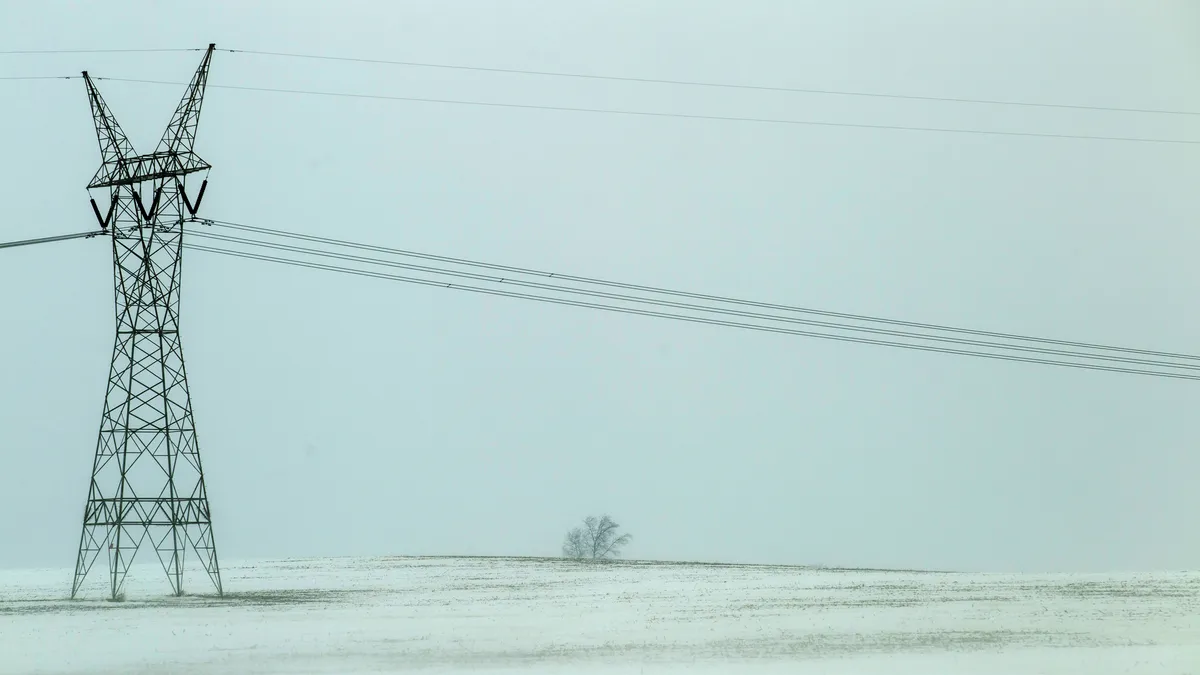Dive Brief:
- Regulatory and industry initiatives “have improved winter readiness,” but many areas of the bulk electric power system still face a risk of energy shortfalls under extreme cold conditions, the North American Electric Reliability Corp. said Thursday in its annual Winter Reliability Assessment.
- NERC is concerned about the potential for freezing temperatures to impact delivery of natural gas to power plants. Outside of Texas, there is “little to no information to indicate that upstream gas producers, gatherers, and processors have improved winterization of their operations,” the report said.
- Natural gas producers pushed back on that assessment. Members of the Natural Gas Supply Association “take a multitude of proactive measures to prepare for winter weather so that we can provide safe and reliable service to our customers,” NGSA President and CEO Dena Wiggins said in a statement.
Dive Insight:
Almost 250 people died in Texas in 2021 during Winter Storm Uri, when freezing temperatures led to a host of energy system failures including the inability of producers to deliver gas to power plants in some instances.
In the wake of Uri, Texas regulators instituted a slate of market improvements and generator weatherization requirements. But NERC officials say they are not aware of similar work in other parts of the country.
“I think the concern is that, while we have standards in place for reliability of electric generation units, we don't know as much about an assured supply of gas,” Mark Olson, NERC’s manager of reliability assessments, said in a Thursday call with journalists.
The gas industry “is taking steps to improve ... but it's just very different, the way electric reliability and gas reliability is managed,” he said.
John Moura, NERC’s director of reliability assessments and performance analysis, said that NGSA has developed winterization guidance for its members. But he also noted that the gas trade group mostly represents larger producers, and there is less certainty around smaller suppliers.
Electric industry winter readiness is governed by statutes and regulation but “on the gas side, there is no high-order regulator that looks at all aspects of the commodity chain,” Moura said. “Therefore, you have that mixed bag of different regulatory approaches on the production side.”
NGSA officials say they are working closely with stakeholders to boost reliability, but that improvements must be made across the energy value chain.
“While the natural gas industry is taking concrete actions to improve operational reliability of its systems, we all have an important role to play and others must also take action to ensure power generation preparedness,” Wiggins said.
NGSA members are taking a “multitude of proactive measures” to prepare for the winter, including “stringent self-inspections prior to anticipated weather conditions,” assisting customers in finding alternative market options, and mitigating weather exposure with “additional supplies and enhanced protections,” according to a fact sheet published by the group.
“NERC’s report once again underscores the serious power supply challenges facing our nation, and the critical importance of securing enough electric generation capacity,” Electric Power Supply Association President and CEO Todd Snitchler said in a statement.
EPSA worked with NGSA and the Interstate Natural Gas Association of America to address gas-electric coordination challenges and officials say the groups provided recommendations for improvements to NERC, the Federal Energy Regulatory Commission, grid operators and the National Association of Regulatory Utility Commissioners.
“Generators and our partners in the natural gas value chain have taken meaningful action to address issues faced during recent storms and to enhance gas-electric coordination,” Snitchler said. “As they do every year, our member companies take significant steps to prepare for winter operations and help ensure optimal performance.”
NERC’s winter reliability assessment concluded that all areas of the bulk power system have adequate resources for normal winter peak-load conditions but “more extreme winter conditions extending over a wide area could result in electricity supply and energy shortfalls.”
Specifically, NERC said:
- In the Midcontinent ISO, a loss of more than 5 GW of coal and gas-fired generation since last winter contributed to a decline in available resources. Fewer dispatchable resources on the grid and an increasing reliance on wind and imports means “the risk of supply shortfall in winter has increased.”
- In New England, dispatchable thermal generation capacity declined 2.6 GW since last winter and forecasted peak demand is up 600 MW. The largest capacity increases year over year were for wind and solar resources, “however, both of those resource types have limited energy production in the winter months.”
- New York could struggle to maintain sufficient reserves during periods of extreme cold weather “if non-firm supply of natural gas to generators is interrupted.”
- For the Southwest Power Pool, the area’s wind resources make up 8% of its generation fleet and “can alleviate firm capacity shortages under the right conditions; however, energy risks emerge during periods of low wind.”
- In Saskatchewan, high numbers of forced generator outages or wind turbine derates and outages due to cold temperatures “could lead to operating reserve shortfalls at peak winter demand levels.”
NERC’s winter reliability assessment included recommendations to reduce the risks of energy shortfalls on the bulk power system, including for reliability coordinators, balancing authorities and transmission operators to review seasonal operating plans and communication protocols, and to implement generator fuel surveys to monitor the adequacy of fuel supplies.















